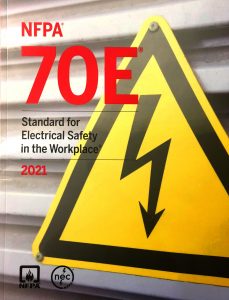
NFPA 70E-2021 - Electrical Safety in the Workplace standard regulates the protection of electrical workers from arc flash and shock injury.
The standard was developed by the National Fire Protection Association (NFPA) in 2000 for use by employers, employees, and the Occupational Safety and Health Administration (OSHA). NFPA 70E-2021 includes the arc flash hazard as a potential danger to workers on and near exposed energized electrical parts. In addition, 70E and IEEE Std 1584 provide guidance on implementing appropriate electrical safety procedures and methods for performing arc flash calculations after a risk assessment, for the purpose of establishing an electrically safe work environment.
The risks of shock, electrocution, arc flash and arc blast are significant health and safety electrical hazards in the workplace. Many electrical incidents could have been prevented through compliance with the latest safety codes and standards and proper job safety planning. NFPA 70E-2021, Standard for Electrical Safety in the Workplace®, is a critical document to help provide a working area for employees that is safe from the unacceptable risk associated with using electricity in the workplace. With the release of the latest edition, the standard clearly establishes safety processes that use policies, and how to establish a hierarchy of risk controls, procedures, and program controls to reduce these risks to an acceptable level. The core objective is practical, accomplishable electrical safety that helps ensure the employee goes home safely at the end of the day. The risk controls discussed in this standard are intended to be sound, viable, workable applications of safety procedures and policies to be implemented by both the employer and employee. The requirements at the heart of the standard are suitable for use and implementation by agencies and employers charged with developing electrical safety plans and electrically safe work conditions using personal protective equipment PPE.
Historically, the National Electric Code (NEC®) and other safety codes were primarily concerned with protection from fire, electrocution, and shock hazards; arc-flash hazards were poorly understood or addressed. This changed in 2002 when NEC technical committees included shock and arc-flash warning label requirements. Some additional requirements related to services have subsequently been added. The National Fire Protection Association (NFPA) is responsible for the NEC (NFPA 70). However, since the NEC (NFPA 70) was concerned mainly with electrical design, construction, and inspection, it could not be adopted by employers and employees to implement arc rating standards for safe work practices. So, Article 110 was developed.
OSHA regulations, in general, have not provided detailed requirements for arc flash safety related to the general industry. In 2015, the OSHA regulations covering electric utilities were updated with more specific arc flash safety requirements. However, OSHA regulations contain what is referred to as the “General Duty” clause that requires employers to protect against any known hazard in the workplace. OSHA has routinely used the General Duty clause to cite and fine employers for failure to provide PPE for arc-flash hazards. In addition, OSHA generally considers the standard the recognized consensus standard for electrical safety and uses it to train its compliance officers.
What is the relationship between OSHA’s standards and NFPA 70E-2021?
The latest edition is an internationally accepted American National Standard that defines electrical safety-related work practices. The US Department of Labor’s Occupational Safety and Health Administration (OSHA) looks to the prescriptive-based requirements of 70E to fulfill the performance-based requirements included in its nfpa codes and standards. 0E explains how the performance-based requirements in the OSHA standards can be met by providing and defining minimum standard industry practices necessary for electrical safety. OSHA is the law, and outlines ways to comply with OSHA’s electrical safety requirements. This symbiotic relationship between 70E and OSHA electrical safety standards helps increase workplace safety.